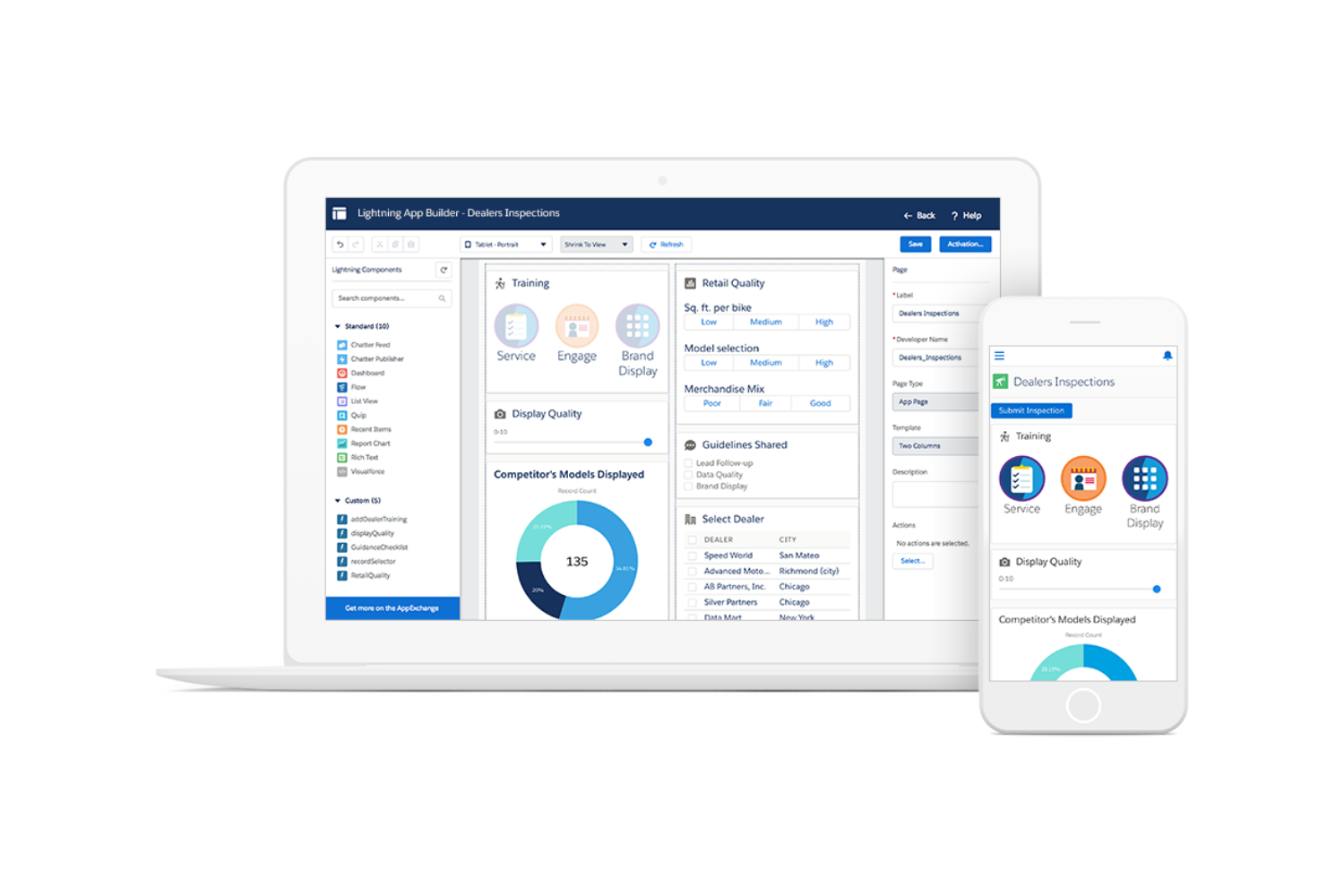Introduction
In today’s digital landscape, businesses are constantly seeking innovative ways to optimize their operations and stay ahead of the competition. Two terms that have emerged in the realm of software and data management are SaaS and DaaS. These acronyms, which stand for Software as a Service and Data as a Service, respectively, offer businesses a more efficient and cost-effective approach to accessing software and managing their data.
SaaS and DaaS are part of the larger trend of cloud computing, which provides businesses the ability to access and utilize software applications and data remotely, through the internet, rather than relying on locally installed solutions. This shift to cloud-based solutions has revolutionized the way businesses operate, allowing for greater flexibility, scalability, and cost-effectiveness.
In this article, we will explore the definitions, benefits, and common examples of both SaaS and DaaS. Additionally, we will compare the two approaches to help you determine which one is best suited for your business needs.
So, whether you’re a small startup looking for an affordable software solution or a large enterprise seeking efficient data management, understanding the differences between SaaS and DaaS will empower you to make the right decision for your business.
Let’s dive in and explore the world of SaaS and DaaS, and discover how these cloud-based approaches can transform the way your business operates.
Definition of SaaS
Software as a Service, commonly known as SaaS, is a software delivery model where applications are provided to users over the internet on a subscription basis. With SaaS, businesses can access and use software applications without the need for installation and maintenance on local devices.
Unlike traditional software models that require upfront purchasing, installation, and ongoing upgrades, SaaS offers a more flexible and cost-effective approach. Users can access the software through a web browser, eliminating the need for complex installations and compatibility issues. The software is centrally hosted and managed by the service provider, allowing businesses to focus on their core activities without the hassle of software maintenance.
SaaS applications are typically accessed through a secure login portal, providing users with remote access to a wide range of software solutions. These solutions can include productivity tools, customer relationship management systems, project management software, human resources management systems, and much more.
One of the key advantages of SaaS is its scalability. Businesses can easily scale their usage up or down depending on their needs. As the software is hosted in the cloud, it can accommodate a growing number of users and handle increased data storage requirements without the need for additional hardware or infrastructure. This flexibility allows businesses to adapt to their changing needs without incurring significant costs.
Another benefit of SaaS is the cost savings it offers. With SaaS, businesses pay a subscription fee based on the number of users and the features they require. This subscription model eliminates the need for upfront expenses associated with purchasing software licenses and hardware. Additionally, regular updates and maintenance are handled by the service provider, saving businesses the time and resources required for software upkeep.
In summary, SaaS is a software delivery model that offers businesses access to a wide range of applications over the internet, eliminating the need for local installation and maintenance. It provides flexibility, scalability, and cost savings, making it an attractive option for businesses of all sizes.
Benefits of SaaS
SaaS offers numerous benefits that make it an appealing choice for businesses of all sizes and industries. Let’s take a closer look at some of the key advantages of adopting the SaaS model.
1. Cost-effectiveness: SaaS eliminates the need for upfront investments in software licenses, infrastructure, and hardware. Instead, businesses pay a subscription fee based on their usage, which reduces the initial financial burden. Additionally, expenses related to software updates, maintenance, and security are taken care of by the service provider.
2. Easy accessibility and scalability: SaaS applications are accessed via a web browser, making them available anytime, anywhere, as long as there is an internet connection. This remote accessibility enables businesses to have their teams work collaboratively from different locations, promoting flexibility and productivity. The cloud-based nature of SaaS also allows for seamless scalability as businesses can easily add or remove users and expand storage capacities without hardware or infrastructure constraints.
3. Seamless updates and maintenance: With SaaS, software updates and maintenance are handled by the service provider. This ensures that businesses are always using the most up-to-date version of the software, with the latest features and security patches. It eliminates the need for manual updates and minimizes downtime for businesses.
4. Enhanced collaboration and integration: SaaS applications often come with built-in collaboration features, allowing team members to work together on projects, share files, and communicate in real-time. Additionally, many SaaS solutions offer integrations with other popular business tools, such as CRM systems or project management platforms, enabling seamless data sharing and workflow automation.
5. Focus on core business activities: By outsourcing software management to a SaaS provider, businesses can focus on their core activities and strategic goals. The service provider takes care of software deployment, updates, and maintenance, freeing up valuable time and resources for businesses to invest in growth-oriented initiatives.
6. Improved security and data backup: SaaS providers prioritize data security and invest in robust security measures to protect sensitive business information. They employ encryption, data backups, and disaster recovery protocols to ensure data integrity and minimize the risk of data loss. Businesses can have peace of mind knowing that their data is stored securely and can be quickly recovered in case of any unforeseen events.
In summary, SaaS offers cost-effectiveness, easy accessibility, scalability, seamless updates, enhanced collaboration, focus on core business activities, and improved security and data backup. These benefits make SaaS an attractive choice for businesses looking to streamline their operations and stay agile in today’s fast-paced digital landscape.
Common Examples of SaaS
SaaS has become increasingly popular across various industries, offering a wide range of software solutions that cater to the diverse needs of businesses. Let’s explore some common examples of SaaS applications that businesses frequently rely on:
1. Customer Relationship Management (CRM) Systems: SaaS-based CRM systems like Salesforce, HubSpot, and Zoho CRM provide businesses with a centralized platform to manage customer interactions, track sales leads, and streamline marketing campaigns.
2. Project Management Tools: SaaS project management tools such as Asana, Trello, and Basecamp help teams collaborate, assign tasks, track progress, and communicate effectively throughout the project lifecycle.
3. Communication and Collaboration Tools: Applications like Slack, Microsoft Teams, and Google Workspace (formerly G Suite) facilitate real-time communication, file sharing, and collaboration among team members, regardless of their geographical locations.
4. Human Resources Management Systems (HRMS): SaaS HRMS platforms such as BambooHR, Workday, and Zenefits assist businesses in managing employee data, payroll, time tracking, performance evaluation, and benefits administration.
5. Accounting and Financial Management Software: SaaS accounting software like QuickBooks Online, Xero, and FreshBooks automate financial processes, including invoicing, expense tracking, budgeting, and financial reporting.
6. E-commerce Platforms: SaaS e-commerce platforms like Shopify, WooCommerce, and BigCommerce help businesses set up and manage online stores easily, providing features for inventory management, order processing, payment gateways, and marketing integration.
7. Email Marketing Tools: SaaS email marketing platforms such as Mailchimp, Constant Contact, and Campaign Monitor enable businesses to create and automate email campaigns, segment subscribers, and track campaign performance.
8. Customer Support Solutions: SaaS customer support software like Zendesk, Freshdesk, and Help Scout assist businesses in managing customer inquiries, tracking support tickets, and providing timely responses to customer queries.
9. Learning Management Systems (LMS): SaaS-based LMS platforms such as MoodleCloud, TalentLMS, and Docebo provide businesses with a centralized hub to manage and deliver online training courses, track progress, and assess learner performance.
10. Content Management Systems (CMS): SaaS CMS platforms like WordPress.com, Wix, and Squarespace enable businesses to create and manage their websites without the need for coding or technical expertise.
These examples are just a glimpse of the wide range of SaaS applications available in the market. By utilizing these cloud-based solutions, businesses can enhance productivity, streamline operations, and focus on their core competencies.
In summary, SaaS encompasses various software solutions, ranging from CRM systems and project management tools to e-commerce platforms and HRMS. These applications provide businesses with the flexibility, scalability, and cost-effectiveness they need to thrive in today’s digital era.
Definition of DaaS
Data as a Service (DaaS) is a cloud computing model that enables businesses to access, manage, and analyze data remotely, without the need for complex on-premises infrastructure. DaaS allows organizations to leverage a scalable and secure infrastructure offered by service providers to store, process, and retrieve data effortlessly.
In the DaaS model, data is stored in the cloud and made accessible to authorized users via the internet. This eliminates the need for businesses to maintain and manage their own data storage systems, databases, and servers. Instead, they can rely on the expertise and infrastructure of DaaS providers to handle data storage, backups, security, and processing.
DaaS offers a range of data-related services, including data integration, data cleansing, data transformation, and data analytics. These services enable businesses to extract valuable insights from their data, make informed decisions, and develop data-driven strategies.
One of the key advantages of DaaS is the scalability it provides. Businesses can rapidly scale their data storage and processing capabilities to meet ever-growing data demands, without the need for upfront investments in infrastructure. DaaS providers offer flexible pricing models based on data storage and processing capacity, allowing businesses to align costs with their actual usage.
Security is another crucial aspect of DaaS. DaaS providers prioritize data security and implement rigorous security measures to protect data against unauthorized access, data breaches, and loss. They employ encryption, data backup, access controls, and other industry-standard security practices to ensure data integrity and compliance with data protection regulations.
By embracing DaaS, businesses can focus on utilizing their data instead of managing the underlying infrastructure. They can leverage advanced analytics and data visualization tools to gain insights, enhance decision-making, and improve business processes. DaaS also enables businesses to collaborate and share data securely across teams, departments, or even with external partners.
Furthermore, DaaS allows businesses to take advantage of external data sources, such as third-party data providers or publicly available data sets. This enriches their existing data and opens up new possibilities for analysis and innovation.
In summary, DaaS is a cloud computing model that provides businesses with remote access to data storage, management, processing, and analysis capabilities. It offers scalability, security, and the ability to leverage external data sources, allowing businesses to harness the power of data for informed decision-making and strategic growth.
Benefits of DaaS
Data as a Service (DaaS) offers businesses numerous benefits that can transform the way they manage and utilize data. Let’s explore some of the key advantages of adopting the DaaS model.
1. Scalability and Cost Efficiency: DaaS eliminates the need for businesses to invest in their own data infrastructure and storage systems. Instead, they can leverage the scalable infrastructure provided by DaaS providers, allowing them to easily scale their data storage and processing capabilities as their needs grow. This scalability ensures businesses only pay for the resources they require, making it a cost-effective solution.
2. Access to Expertise and Infrastructure: DaaS providers specialize in data management and offer a dedicated team of experts who manage data storage, backups, security, and processing. This allows businesses to leverage the know-how and infrastructure of the providers, offloading the burden of maintaining complex data systems. By relying on professionals, businesses can ensure data is stored securely, backed up regularly, and managed efficiently.
3. Enhanced Data Security and Compliance: DaaS providers prioritize data security and implement robust measures to protect sensitive data from unauthorized access, breaches, and loss. These measures typically include encryption, access controls, regular backups, and compliance with data protection regulations. By relying on DaaS, businesses can improve their data security practices and ensure compliance with industry standards.
4. Data Integration and Enrichment: DaaS enables businesses to integrate and enrich their data by leveraging external data sources. This can include third-party data providers, publicly available data sets, or even data from partners or suppliers. By combining internal and external data sources, businesses can gain deeper insights, identify patterns, and make informed decisions based on a more comprehensive view of their operations and market dynamics.
5. Enhanced Data Analytics and Insights: DaaS provides businesses with access to advanced analytics tools and capabilities. By leveraging these tools, businesses can analyze their data effectively, uncover hidden patterns, trends, and correlations, and derive actionable insights. This data-driven approach can help businesses improve decision-making, optimize processes, and drive strategic growth.
6. Data Sharing and Collaboration: DaaS enables secure data sharing and collaboration across teams, departments, or even with external partners. This ensures that the right people have access to the right data at the right time, promoting collaboration, transparency, and efficiency. By facilitating data sharing, DaaS enhances cross-functional collaboration and enables data-driven decision-making across the organization.
7. Improved Data Quality and Governance: DaaS providers often offer data cleansing and data quality management solutions. These tools help businesses ensure data accuracy, consistency, and integrity. By maintaining high-quality data, businesses can make more reliable decisions, improve operational efficiency, and meet regulatory compliance requirements.
In summary, DaaS offers scalability, cost efficiency, access to expertise and infrastructure, enhanced data security and compliance, data integration and enrichment, enhanced data analytics and insights, data sharing and collaboration, and improved data quality and governance. By adopting DaaS, businesses can unlock the full potential of their data assets, gain a competitive advantage, and accelerate their digital transformation initiatives.
Common Examples of DaaS
Data as a Service (DaaS) encompasses a wide range of offerings that allow businesses to access and leverage data remotely through cloud-based solutions. Let’s delve into some common examples of DaaS applications that are widely used across industries:
1. Data Integration Platforms: DaaS data integration platforms such as Informatica Cloud, Dell Boomi, and SnapLogic enable businesses to integrate data from various sources, including databases, applications, and external systems. These platforms provide seamless data movement, transformation, and synchronization, facilitating data consolidation and enabling real-time insights.
2. Data Warehousing Services: DaaS data warehousing services, like Amazon Redshift, Google BigQuery, and Snowflake, provide businesses with scalable and performant data storage solutions. They offer a centralized repository for structured and unstructured data, allowing for efficient data access, querying, and analytics.
3. Business Intelligence (BI) Tools: DaaS-based BI tools, such as Tableau, Power BI, and Looker, allow businesses to analyze and visualize data to gain actionable insights. These tools provide intuitive interfaces and robust reporting capabilities, enabling users to create interactive dashboards, perform ad-hoc data exploration, and share insights across the organization.
4. Data Analytics Services: DaaS data analytics services, like Google Analytics, Mixpanel, and Adobe Analytics, provide businesses with valuable insights into user behavior, website performance, and marketing campaigns. These services offer advanced analytical capabilities, including automated reporting, funnel analysis, cohort analysis, and segmentation.
5. Data Visualization Platforms: DaaS data visualization platforms, such as Datawrapper, Chartio, and Qlik Sense, enable businesses to create interactive and visually appealing data visualizations. These platforms allow users to represent complex data sets in a simplified and meaningful way, facilitating better understanding and decision-making.
6. Data Cleansing and Enrichment Services: DaaS data cleansing and enrichment services, like Experian Data Quality, Melissa, and Openprise, help businesses improve the quality of their data. These services identify and correct errors, inconsistencies, and duplicates in the data, ensuring accuracy and reliability. Additionally, they offer data enrichment capabilities, appending external data to existing datasets to enhance data insights.
7. Real-time Data Streams: DaaS-based real-time data streams like Apache Kafka, AWS Kinesis, and Azure Event Hubs enable businesses to ingest, process, and analyze data in real-time. These platforms provide scalable, fault-tolerant, and low-latency data streaming capabilities, empowering businesses to make instant data-driven decisions.
8. Geospatial Data Services: DaaS geospatial data services, such as Google Maps Platform, Esri ArcGIS Online, and Mapbox, offer businesses access to geographic data and mapping functionality. These services provide location-based insights, spatial analysis, and interactive maps to enhance decision-making in areas such as logistics, marketing, and urban planning.
9. Social Media Data APIs: DaaS social media data APIs, like Facebook Graph API, Twitter API, and LinkedIn API, provide businesses with programmatic access to social media data. These APIs enable businesses to pull and analyze social media data for social listening, sentiment analysis, brand monitoring, and targeted advertising.
10. Data Marketplaces: DaaS data marketplaces, such as Data.gov, Kaggle, and AWS Data Exchange, offer a vast collection of publicly available and commercial datasets. These marketplaces provide businesses with access to a wide range of data for research, analysis, and model training purposes.
These examples showcase the diversity of DaaS offerings available in the market. By leveraging these solutions, businesses can tap into the power of data and gain valuable insights to drive growth, innovation, and competitive advantage.
Comparison Between SaaS and DaaS
SaaS and DaaS are both cloud-based models that offer businesses flexibility, scalability, and cost-efficiency. However, there are key differences between the two approaches that make them suitable for different business needs. Let’s compare SaaS and DaaS across various aspects.
1. Data Ownership and Management: In SaaS, the software application is owned and managed by the service provider, while the data generated or entered into the application is typically owned by the business. On the other hand, DaaS involves the outsourcing of both data storage and management to the service provider. The provider assumes responsibility for data backups, security, and processing, relieving businesses of the associated tasks.
2. Infrastructure Requirements: SaaS eliminates the need for businesses to invest in their own infrastructure, as the software is hosted and managed by the service provider. In contrast, DaaS relieves businesses of the burden of maintaining their own data storage infrastructure and servers. The infrastructure required for data storage and processing is provided by the DaaS provider.
3. Application Customization: SaaS applications are often designed to cater to a wide range of businesses, offering standard features and configurations. Customization options may be limited, and businesses typically rely on the service provider to update and enhance the application. DaaS, on the other hand, allows businesses to have more flexibility in terms of data customization and analysis. They can integrate and analyze data from multiple sources, apply specific algorithms and models, and gain deeper insights.
4. Data Security and Compliance: Both SaaS and DaaS providers prioritize data security. However, since DaaS involves the storage and processing of business data by the provider, there may be concerns about data confidentiality and compliance with industry-specific regulations. Businesses must carefully evaluate the security measures and certifications provided by the DaaS provider to ensure data protection and compliance.
5. Cost Model: SaaS applications typically follow a subscription-based pricing model, where businesses pay a regular fee based on the number of users and the features they require. This allows businesses to align costs with actual usage. DaaS costs, on the other hand, are dependent on data storage and processing requirements, allowing businesses to scale up or down as needed.
6. Flexibility and Integration: SaaS applications provide businesses with reliable and user-friendly software solutions, but customization and deep integrations may be limited. DaaS, with its focus on data integration and analysis, offers more flexibility in terms of data sources, algorithms, and integrations with other systems, such as BI tools or data warehouses.
7. User Experience: SaaS applications prioritize ease of use and user experience to cater to a broad user base. They often provide intuitive interfaces and standardized workflows. DaaS, on the other hand, focuses on providing robust data management and analysis capabilities, which may require some level of technical expertise for optimal utilization.
In summary, SaaS and DaaS differ in terms of data ownership, infrastructure requirements, customization options, data security, cost models, flexibility, and user experience. Businesses need to assess their specific requirements and priorities to determine whether a SaaS or DaaS approach is more suitable for their data management and software needs.
Final Thoughts
SaaS and DaaS have revolutionized the way businesses access software applications and manage their data. These cloud-based models offer numerous benefits, such as cost-effectiveness, scalability, enhanced security, and streamlined operations.
SaaS provides businesses with easy access to a wide range of software applications without the need for complex installations or maintenance. It offers flexibility, scalability, and cost savings, making it an attractive option for businesses of all sizes and industries.
On the other hand, DaaS provides businesses with the ability to store, manage, and analyze data remotely, without the need for on-premises infrastructure. It offers scalability, access to expertise, and enhanced data security. DaaS enables businesses to leverage external data sources and gain valuable insights for informed decision-making.
The choice between SaaS and DaaS ultimately depends on the specific requirements and priorities of a business. SaaS is ideal for businesses seeking software solutions that are easy to implement, cost-effective, and readily available. DaaS, on the other hand, is well-suited for businesses that prioritize data management, analysis, and customization.
It’s important for businesses to conduct a thorough evaluation of their needs, considering factors such as data ownership, scalability, customization options, security, and cost models. Consulting with IT professionals and considering feedback from other businesses in similar industries can help inform the decision-making process.
In summary, both SaaS and DaaS offer businesses the opportunity to leverage cloud-based solutions for enhanced efficiency and productivity. By understanding the unique characteristics and benefits of each model, businesses can make informed decisions and harness the power of technology to drive growth and success.

























